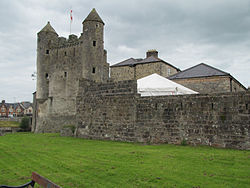Enniskillen Castle: Difference between revisions
Created page with "{{Infobox castle |name=Enniskillen Castle |town=Enniskillen |county=Fermanagh |picture=Enniskillen Castle by Paride.JPG |picture caption=Enniskillen Castle |latitude=54.346 |l..." |
m clean up, typos fixed: eight day → eight-day |
||
| (One intermediate revision by one other user not shown) | |||
| Line 16: | Line 16: | ||
==History== | ==History== | ||
The first castle was built on this site by Hugh Maguire in the 16th century.<ref name="EC">{{cite web | title=Enniskillen Castle | work=Environment and Heritage Service NI - State Care Historic Monuments | url=http://www.ehsni.gov.uk/state_care_monuments_2007.pdf | accessdate=2007-12-03}}</ref> It featured greatly in Irish rebellions against English rule in the 16th century and was taken after an eight day siege in 1594. | The first castle was built on this site by Hugh Maguire in the 16th century.<ref name="EC">{{cite web | title=Enniskillen Castle | work=Environment and Heritage Service NI - State Care Historic Monuments | url=http://www.ehsni.gov.uk/state_care_monuments_2007.pdf | accessdate=2007-12-03}}</ref> It featured greatly in Irish rebellions against English rule in the 16th century and was taken after an eight-day siege in 1594. | ||
In 1607 the castle was remodelled and refurbished by Captain William Cole. The riverside tower at the south, known as the Watergate, was added at this time. In the 18th century the castle was remodelled as the Castle Barracks. | In 1607 the castle was remodelled and refurbished by Captain William Cole. The riverside tower at the south, known as the Watergate, was added at this time. In the 18th century the castle was remodelled as the Castle Barracks. | ||
The distinctive shape of the Watergate has become a local symbol, appearing on the | The distinctive shape of the Watergate has become a local symbol, appearing on the arms of Fermanagh County Council and its successors. | ||
==Features== | ==Features== | ||
The Castle provided the main defence for the west end of the town and guarded the [[Sligo]] road. It consists of two sections, a central tower keep and a curtain wall which was strengthened with small turrets called Bartizans. <ref name="EC"/> The design of the castle has strong influence from Scottish Baronial architecture. This can be particularly seen in the Watergate, which features two corbelled circular tourelles which were probably built about 1609.<ref>{{cite book | last=O'Neill, B (ed). | year=2002 |title=Irish Castles and Historic Houses | publisher=Caxton Editions | location=London | page=17}}</ref> Since then it has been substantially rebuilt. It is a State Care Historic Monument.<ref name="EC"/> | The Castle provided the main defence for the west end of the town and guarded the [[Sligo]] road. It consists of two sections, a central tower keep and a curtain wall which was strengthened with small turrets called Bartizans.<ref name="EC"/> The design of the castle has strong influence from Scottish Baronial architecture. This can be particularly seen in the Watergate, which features two corbelled circular tourelles which were probably built about 1609.<ref>{{cite book | last=O'Neill, B (ed). | year=2002 |title=Irish Castles and Historic Houses | publisher=Caxton Editions | location=London | page=17}}</ref> Since then it has been substantially rebuilt. It is a State Care Historic Monument.<ref name="EC"/> | ||
==Fermanagh County Museum== | ==Fermanagh County Museum== | ||
Latest revision as of 22:03, 30 January 2016
| Enniskillen Castle | |
|
Fermanagh | |
|---|---|
 Enniskillen Castle | |
| Location | |
| Location: | 54°20’46"N, 7°38’38"W |
| Town: | Enniskillen |
| History | |
| Built 1567 | |
| Information | |
| Owned by: | (State care) |
Enniskillen Castle stands in Enniskillen, the county town of Fermanagh. It was originally built in the 16th century and now houses the Fermanagh County Museum and the regimental museum of the Royal Inniskilling Fusiliers and the 5th Royal Inniskilling Dragoon Guards.
History
The first castle was built on this site by Hugh Maguire in the 16th century.[1] It featured greatly in Irish rebellions against English rule in the 16th century and was taken after an eight-day siege in 1594.
In 1607 the castle was remodelled and refurbished by Captain William Cole. The riverside tower at the south, known as the Watergate, was added at this time. In the 18th century the castle was remodelled as the Castle Barracks.
The distinctive shape of the Watergate has become a local symbol, appearing on the arms of Fermanagh County Council and its successors.
Features
The Castle provided the main defence for the west end of the town and guarded the Sligo road. It consists of two sections, a central tower keep and a curtain wall which was strengthened with small turrets called Bartizans.[1] The design of the castle has strong influence from Scottish Baronial architecture. This can be particularly seen in the Watergate, which features two corbelled circular tourelles which were probably built about 1609.[2] Since then it has been substantially rebuilt. It is a State Care Historic Monument.[1]
Fermanagh County Museum
The castle is now home to the Fermanagh County Museum, which focuses on the county's history, culture and natural history. Exhibits include the area's prehistory, natural history, traditional rural life, local crafts and Belleek Pottery, and history of the castle.
Inniskillings Museum
The castle also houses the Inniskillings Museum, which is the regimental museum of the Royal Inniskilling Fusiliers and the 5th Royal Inniskilling Dragoon Guards. Displays include uniforms, medals, flags, regimental regalia, weapons and other military memorabilia.
-
The courtyard of the Castle
-
Reconstruction of the Castle
-
The barracks was built inside the walls
Outside links
| ("Wikimedia Commons" has material about Enniskillen Castle) |
References
- ↑ 1.0 1.1 1.2 "Enniskillen Castle". Environment and Heritage Service NI - State Care Historic Monuments. http://www.ehsni.gov.uk/state_care_monuments_2007.pdf. Retrieved 2007-12-03.
- ↑ O'Neill, B (ed). (2002). Irish Castles and Historic Houses. London: Caxton Editions. p. 17.



